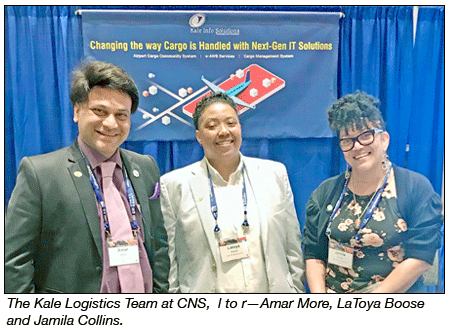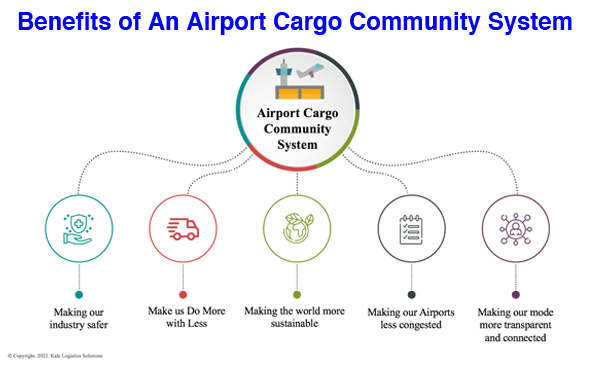Amar More is the President and CEO of
Kale Logistics, a company that has made its way through the airport and
airfreight communities in the last 10+ years with great success, starting
from the beginning and getting to very high results in terms of business
and geographical coverage. Read on until the end to get acquainted with
the number of communities that cooperate with Kale. Amar More’s presentation
told us all that he knows about how community systems can transform an airport
ecosystem into a more profitable, efficient and environmentally compliant
business place.
 Today
May 25th at CNS Amar More, the distinguished speaker from India, gave his
presentation banking on the long experience he acquired as Domain Coordinator
for Cross Border Management at the United Nations (United Nations Centre
for Trade Facilitation and Electronic Business), UN/CEFACT) in Geneva. Amar
is also listed on the panel of experts for trade facilitation at the same
body and is a Board Member of the International Air Cargo Association (TIACA)
in Miami. Amar chaired the Asia Pacific region on the executive committee
of the International Port Community Systems Association (IPCSA) in the UK
and is a Member of the National Council for Logistics with Chartered Institute
of Logistics and Transport, globally active on conceptualizing trade facilitation
initiatives to usher in “Ease of Doing Business” by using digital
technology. One could say “a man with a mission”, or so it appears. Today
May 25th at CNS Amar More, the distinguished speaker from India, gave his
presentation banking on the long experience he acquired as Domain Coordinator
for Cross Border Management at the United Nations (United Nations Centre
for Trade Facilitation and Electronic Business), UN/CEFACT) in Geneva. Amar
is also listed on the panel of experts for trade facilitation at the same
body and is a Board Member of the International Air Cargo Association (TIACA)
in Miami. Amar chaired the Asia Pacific region on the executive committee
of the International Port Community Systems Association (IPCSA) in the UK
and is a Member of the National Council for Logistics with Chartered Institute
of Logistics and Transport, globally active on conceptualizing trade facilitation
initiatives to usher in “Ease of Doing Business” by using digital
technology. One could say “a man with a mission”, or so it appears.
Transformation opportunities in the Airport
eco-system was the next topic offered to the audience by explaining the
opportunities of the airport ecosystem in transforming itself. There are
procedural bottlenecks, high track congestion at the airport, due to manual
operations, no real time shipment visibility, lack of data in security and
compliance as well as lack of advance information sharing with the cargo
ground handler. There is also a lack of harmonized process with an excess
of bureaucracy requiring 30+ documents, more than 120 copies to be made
and 200 signatures to be collected.
If
you take a look at the digital transformation of the international trade
represented by UN/CEFACT recommendation number 33 it is staggering to understand
how complex is the level of interaction between and among these participants,
which the speaker was trying to explain:
Digital Transformation of the International Trade
An Airport Cargo Community platform is an
electronic platform that facilitates digital interactions between airport
stakeholders viz. Importer / Exporters, Forwarders, Customs Brokers, Carriers,
Customs, GHAs, Other Stakeholders at the airport.
What followed was in fact the explanation
of the interactions of the participants in a cargo community system: some
take place at one to one level, some one to many and some many to many;
interactions appear to take place and the level of reporting and interdependence
of the body with a view to clarifying the reporting level of the various
entities: evidently the stakeholders in the cargo sector of aviation are
many, far too many for a simplistic approach. These include terminal operators,
transporters, government agencies and Chambers of Commerce, cargo handlers,
freight forwarders, airlines, shippers, consignees, banks, Customs, insurance
companies, customs brokers and others.
The next point that was made was concerning
the Air Cargo Sector evolution; from a first generation cargo sector with
simple IT instruments there was an evolution into a second generation
with instruments such as EDI, tracking, online appointments and payments,
etc.
Nowadays we have what we call “next
generation ACS”, where more sophisticated instruments are made available,
such as advance filing, online vehicle tokens, etc.
This appraisal nicely led the audience
to hear about Kale’s ACS Pilot and its results. 389 trucks were
handled with 1839 shipments for a total of 1.5 million pounds of cargo,
with savings of $69,000 for driver labor, 1945 hours and in excess of
nine million grams of CO2. Thus the results of the pilots were both interesting
from the business point of view and the advancement of the environment
point of view.
Amar More continued explaining how to help
the air cargo ecosystem with efficacy in the cargo business, on three
levels: the first at the commercial level, helping airlines and stakeholders
acquire profitability with concession models that would increase their
ability to grow, focusing on service levels towards customers. The second
level deals with the growth of business with marketing tools for attracting
more cargo, as well as electronic retailing and commerce capabilities,
by making airports attractive for shippers and airlines to become regional
cargo gateways, with better understanding of the commodities and the customer
requirements. In addition, a better understanding of the trade flows as
well as partnering with other airports in developing digital corridors.
The third level deals with sustainability
and security with reduced carbon footprint, lower dwell times, whist helping
the community operate in a safer manner in the pandemic times, as well
as saving trees by promoting paperless trade.
Helping the Air Cargo Ecosystem with Efficacy
of Cargo Business was still the title of the slide provided as next point
for the debate. This one was looking at the same issue also on three levels:
the operational efficiency that can deliver effective warehouse planning
and utilization of storage space and equipment, the instant and real time
update of shipment status, and process automation addressing the issue
of staff shortage. The second tier deals with cost reduction, which comes
from data handling, by which costs are reduced, as well as information
gathering costs like phone calls, emails and physical visits, which are
avoided.
In “Enhancing throughput of Airport
Cargo Facilities” it was interesting to see the enhancement of the
throughput of the air cargo facilities in Mumbai, where the small facility
available moved around 1,500 trucks a day and the small warehouse processed
close to 1,000,000 tonnes of air cargo per annum without any MHS.
 |
The remarkable chart above tells us the story
of how it is possible to transform the airport cargo community system
by making the industry safer, making us do more business with less, making
the world more sustainable, making our airports less congested, by using
the Kale modus operandi in a more transparent and connected manner.
The key recommendations that our “man
with a mission” Amar More delivered to the audience were to encourage
the creation of air cargo community systems in all the airports in a country,
then linking individual air cargo community systems at a national level
to create national air cargo community systems (NACS), followed by the
exhortation to link the individual ACS or NACS with those in other countries
through digital trade corridors. The 4th recommendation was inevitably
to link these systems with other modes of transport for a complete national
digital logistics infrastructure.
Amar More concluded his presentation with
a bird’s eye view or all the achievements of his company, and with
thanks and we are sure more than one of our readers want to thank Amar
More for his Kale Logistics’ achievements, which contribute to their
thriving business.
GDA |




 Today
May 25th at CNS Amar More, the distinguished speaker from India, gave his
presentation banking on the long experience he acquired as Domain Coordinator
for Cross Border Management at the United Nations (United Nations Centre
for Trade Facilitation and Electronic Business), UN/CEFACT) in Geneva. Amar
is also listed on the panel of experts for trade facilitation at the same
body and is a Board Member of the International Air Cargo Association (TIACA)
in Miami. Amar chaired the Asia Pacific region on the executive committee
of the International Port Community Systems Association (IPCSA) in the UK
and is a Member of the National Council for Logistics with Chartered Institute
of Logistics and Transport, globally active on conceptualizing trade facilitation
initiatives to usher in “Ease of Doing Business” by using digital
technology. One could say “a man with a mission”, or so it appears.
Today
May 25th at CNS Amar More, the distinguished speaker from India, gave his
presentation banking on the long experience he acquired as Domain Coordinator
for Cross Border Management at the United Nations (United Nations Centre
for Trade Facilitation and Electronic Business), UN/CEFACT) in Geneva. Amar
is also listed on the panel of experts for trade facilitation at the same
body and is a Board Member of the International Air Cargo Association (TIACA)
in Miami. Amar chaired the Asia Pacific region on the executive committee
of the International Port Community Systems Association (IPCSA) in the UK
and is a Member of the National Council for Logistics with Chartered Institute
of Logistics and Transport, globally active on conceptualizing trade facilitation
initiatives to usher in “Ease of Doing Business” by using digital
technology. One could say “a man with a mission”, or so it appears.
